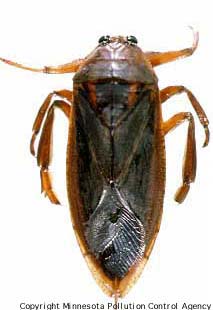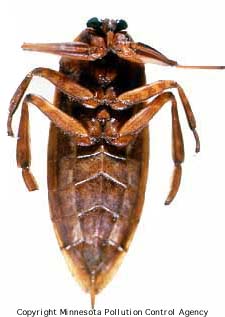

Lethocerus americanus is a large water bug commonly found in ponds and slowly moving fresh water. Also known as the "toe biter" for its encounters with swimmers, it has the reputation of inflicting painful bites when carelessly handled. It normally feeds on other pond life: insects, tadpoles, salamander, small fish, and snails. These large tan or brown bugs may leave their habitat at night in search of mates or another pond. It is thought that the relative nearness of bright lights for a creature that evolved using celestial navigation, results in disorientation, spiral flight paths, and eventual death from exhaustion. This would account for the occasional find of several dead giant water bugs underneath street lamps.
CommentsLethocerus americanus is a large bug of the order Hemiptera, Family Belostomatidae. This family has up to 150 species of giant water bugs, the largest being up to 150 mm long, the largest insects of any kind. [1] Lethocerus americanus, the common North American member, is brown or tan, oval and flattened, and ranges from 12-65mm (about 1-2 x inches) in length. It normally inhabits vernal ponds, marshes, lakes, slow moving rivers and streams. It is also occasionally encountered in swimming pools. Lethocerus normally feeds on insects, tadpoles, salamander, small fish, and snails. [2]
Adult insects do not breathe underwater, and Lethocerus returns to the surface regularly to breath though two short tubes, strap-like appendages, at the tip of the abdomen. These tubes allow for exchange of air from the atmosphere to a bubble of air trapped under the wings. Air enters the insect's body through holes, called spiracles, in the abdomen. [3] Swimming is accomplished by means of flattened hind legs that are modified for this purpose and resemble oars.[4] The powerful forelegs are tipped with a curved hook shaped claw and are used to grasp and hold prey. Lethocerus then injects a poison through a needle-like beak and sucks the tissue fluid of their prey. Lethocerus can be vicious biters, inflicting pain when handled. The nickname for this insect is "toe biter" which is derived from the occasional attack on swimmers.
Despite the normal habitat of these insects, people most often encounter adult giant water bugs out of water.[3] Adults often fly around, mainly at night, presumably searching for other water bodies to colonize or for mates. They are sometimes called "electric light bugs" because of their habit of flying to lights. It is thought that like several other insects (notably moths) that evolved using light sources as beacons to orient their flight. With celestial navigation, the points of light are fixed relative to the moving insect. On the other hand, sources of artificial light such as street lamps are much closer and change position relative to the path of the moving insect. If navigation is based on using a point of light as a fixed source, the end result will then be a path which spirals toward the light. Perhaps water bugs and other insects are not so much "attracted " to light, but that they are disoriented by it. "In the end they become exhausted from aimlessly flying around the light and end up lying on the ground below street lights on roads or parking lots." [3]
Lethocerus apparently has no special medical significance other than the ability to cause painful bites. It does not appear to be a disease vector or a cause of major injury. Giant water bugs appear to be a good source of insect muscle for scientific investigation, and reports on muscle structure and function account for almost all citations of this insect in the medical literature.
Occasionally one may encounter these large insects in ponds or streams. If removed from water they have been known to feign
death and eject a fluid from the anus. If not allowed to return to water, they tend to die relatively quickly. [4] However, when handling an apparently dead giant water but, one might exercise caution until that status is certain , or face
painful consequences.